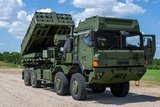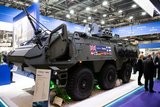MEADS achieves new programme milestone
The Medium Extended Air Defense System (MEADS) has marked a new milestone with the successful interception of two simultaneous targets attacking from opposite directions during a stressing demonstration at White Sands Missile Range. The targets were both destroyed and the flight test achieved all criteria for success.
The demonstration was part of tests on the system’s 360-degree air and missile defence (AMD) capabilities. All elements of the MEADS system were tested, including the 360-degree MEADS surveillance radar, a networked MEADS battle manager, two lightweight launchers firing PAC-3 Missile Segment Enhancement (MSE) missiles and a 360-degree MEADS Multifunction Fire Control Radar (MFCR).
All system elements are reported to have worked as planned.
During the test, the first target, a QF-4 air-breathing target, approached from the south as a Lance missile, flying a tactical ballistic missile trajectory, attacked from the north. The surveillance radar acquired both targets and provided target cues to the MEADS battle manager, which generated cue commands for the MFCR. The MFCR tracked both targets successfully and guided missiles from launchers in the Italian and German configuration to successful intercepts.
Gregory Kee, general manager, NATO MEADS Management Agency, said: ‘Today's successful flight test is the culmination of three countries working together to design, develop and build the most advanced and capable air and missile defence weapon system in the world. No fielded ground-mobile AMD System can intercept targets from two directions at the same time, as MEADS did today.
‘MEADS technology can now be leveraged as mature, network-ready battle management, sensors and launchers to achieve the networked AMD capabilities envisioned by Germany, Italy and the US.’
The test also demonstrated over-the-shoulder manoeuvrability of the PAC-3 MSE missile in engaging the targets.
The MEADS programme has now achieved three flight test objectives; also including the successful simulated intercept of an air-breathing target; and the acquiring, tracking and destroying of an MQM-107 target.
More from Land Warfare
-
![Lithuanian 1st Division to achieve initial operating capability in 2026]()
Lithuanian 1st Division to achieve initial operating capability in 2026
Lithuania is one of the countries stepping up its defences in the face of the war in Ukraine with a particular focus on its neighbour and Russian ally Belarus, which has been making incursions into Lithuania’s airspace with balloons and drones.
-
Medium knocked out of British Army LMP, with CAVS as heavyweight champion
As the British Army seeks to modernise and consolidate its diverse vehicle fleet, yet another change in direction is underway.
-
![Energy evolution: How laser defence systems are powering the next phase of air defence (podcast)]()
Energy evolution: How laser defence systems are powering the next phase of air defence (podcast)
Laser-based air defence is moving from promise to deployment as global threats evolve. In this special podcast, we explore how high-energy laser systems are reshaping interception strategies.
























